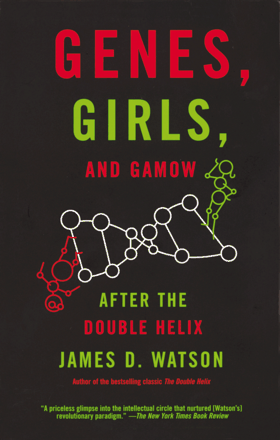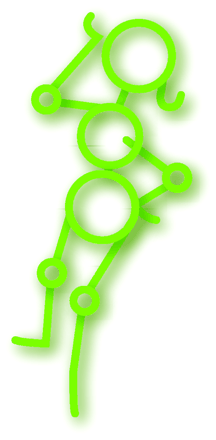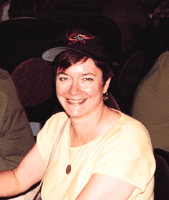Lord Jim, or What's That Knife-like Pain in My Back?
Lord Jim, or What’s That Knife-like Pain in My Back?
Genes, Girls, and Gamow: After the Double Helix. James D. Watson. New York: Vintage Books; 2003. 336 pages. $14.00. ISBN: 0-375-72715-9

The ostensible three-fold foci of this book by James Watson are the research that followed the discovery of the DNA double helix, the fun-loving and loquacious George Gamow, and Jim Watson’s own quest for a wife. However, to quote from the forward—one of the most entertaining parts of the book—written by Linus Pauling’s son Peter, "In this book, the subject is Jim Watson." Peter Pauling is only one of the many individuals whose personal life is skewered by Watson in this book. None of the key players in the DNA-RNA drama escapes Watson’s derogatory condescension, although it is clear that Watson holds some in higher regard than others. Reading this book is like reading a Who’s Who of nucleic acid research; in fact, at the beginning of the book is a Cast of Characters.
George Gamow, a theoretical atomic physicist who moved into the RNA arena and subsequently into astrophysics, fared better than most. Clearly, Watson admired this high-spirited, hard-drinking Russian. One of the more charming parts of the book is the appendix that consists of many of Gamow’s letters to Watson, complete with doodles. It was Gamow who invented the concept of the RNA Tie club where each of the twenty members received a tie with the depiction of an RNA (now known to be tRNA) molecule on it and was assigned the name of one of the known amino acids as his nom de club. The club included such luminaries as Richard Feynman, Erwin Chargaff, and Max Delbrück, in addition to Watson and Gamow. Perhaps with this high-profile, international membership it wasn’t such a zany idea to try to obtain funding for the ties first from the Office of the Army Quartermaster Corps and subsequently from the National Science Foundation.
Watson’s feelings about the codiscoverer of the double helix are somewhat more ambiguous. At times he seems to genuinely admire Francis Crick, and at other times, Crick, like many others, is the victim of Watson’s barbed assessment of his personality. Names like Alex Rich, Linus Pauling, Leslie Orgel, John Kendrew, Max Perutz, Rosalind Franklin, Wally Gilbert, and Sydney Brenner appear frequently throughout the book. Descriptions of their research efforts are perfunctory and easily understood only by those already "in the know." Descriptions of their lives, loves, and marital difficulties are given more attention, but usually only insofar as they impacted Jim Watson’s own love life or research endeavors.
Watson seems to have had a hard time understanding why he could not find a wife. And he does try to paint a pathetic picture of a young, bright, promising biochemist seeking his intellectual soul mate. Reading the book, however, it is easy to see how his pomposity and arrogance would turn off any young woman who had an ounce of brains in her head. Throughout the book Watson is fixated on the young daughter of his good friend Ernest Mayr, and Watson deserves some credit for allowing the reader to see his insecurities about Christa and their relationship.

Watson writes much as he speaks, jumping from point to point with little transition. The best analogy I can think of for reading this book is that of listening to someone talk nonstop about three years of his life, often relegating a whole month’s worth of activity to a single sentence. Most of the book covers the period from 1953 to 1956 during which Watson and others were trying to understand how DNA interacted with RNA and how proteins were synthesized. Their efforts proceeded in fits and starts, hampered greatly by the fact that RNA was not cooperating in giving them an interpretable X-ray crystallographic structure. In truth, very little happened during this three-year period, except for the accumulation of negative data that ultimately led to the correct answers.
Curiously, after chapters that go almost month-by-month, the book ends with an epilogue that covers thirteen years (1956–1968), as if he grew tired of writing the book. The research that defined how DNA codes for proteins and how proteins are synthesized is given short shrift after pages describing how theories were tested and didn’t work. It is also curious that after 235 pages of detail about his dates and social failures, Watson devotes less than a page to meeting and marrying his wife. Perhaps he finally met someone he cared enough about to not subject her to the skewering he gave the rest of his friends, colleagues, and acquaintances. I couldn’t help but wonder if the book expresses how Watson actually felt about these people at that time, or how he feels now, looking through the lens of time.
Peter Pauling refers to the people mentioned in this book as "victims," and this is probably an apt term. There are many prominent people who are probably less than happy to have it put before the public-at-large that they had to get married because of an unwanted pregnancy, or that they got unceremoniously dumped by their first lover, or that they were effete snobs, or religious bigots. However, as a member of the salacious public, I found that to be one of the things that makes the book readable. Were it only about Jim Watson, his self-indulgent intellect, and his lovelorn youth, it would be a very boring opus.
James Watson shared the Nobel Prize for Physiology or Medicine in 1962, along with Francis Crick and Maurice Wilkins for their discovery of the double-helical structure of DNA. He was subsequently the Director of the Cold Spring Harbor Laboratory, and Director of the National Center for Human Genome Research and is currently the President of Cold Spring Harbor Laboratory.

- © American Society for Pharmacology and Experimental Theraputics 2003



